SanDisk Ultra Plus SSD Review (256GB)
by Anand Lal Shimpi on January 7, 2013 9:00 AM ESTRandom Read/Write Speed
The four corners of SSD performance are as follows: random read, random write, sequential read and sequential write speed. Random accesses are generally small in size, while sequential accesses tend to be larger and thus we have the four Iometer tests we use in all of our reviews.
Our first test writes 4KB in a completely random pattern over an 8GB space of the drive to simulate the sort of random access that you'd see on an OS drive (even this is more stressful than a normal desktop user would see). I perform three concurrent IOs and run the test for 3 minutes. The results reported are in average MB/s over the entire time. We use both standard pseudo randomly generated data for each write as well as fully random data to show you both the maximum and minimum performance offered by SandForce based drives in these tests. The average performance of SF drives will likely be somewhere in between the two values for each drive you see in the graphs. For an understanding of why this matters, read our original SandForce article.
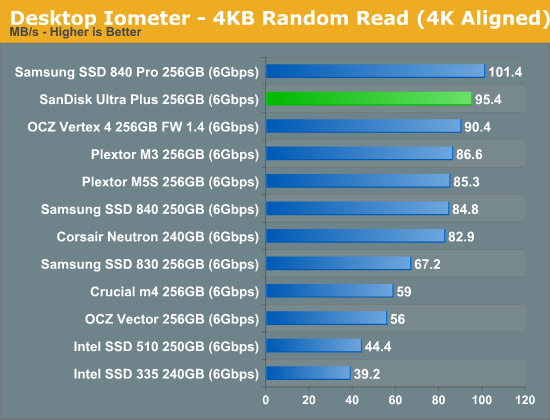
The Ultra Plus gets off to a good start, doing very well in our low queue depth random read test, bested only by Samsung's SSD 840 Pro out of our list of contenders here.

Random write performance is pretty good but the Ultra Plus doesn't hit any of the insanely high speeds set by most of the modern drives. Note that its performance is equal to the Samsung SSD 830, which was a favorite of ours. Not having a first class showing here isn't a huge problem.
Many of you have asked for random write performance at higher queue depths. What I have below is our 4KB random write test performed at a queue depth of 32 instead of 3. While the vast majority of desktop usage models experience queue depths of 0 - 5, higher depths are possible in heavy I/O (and multi-user) workloads:
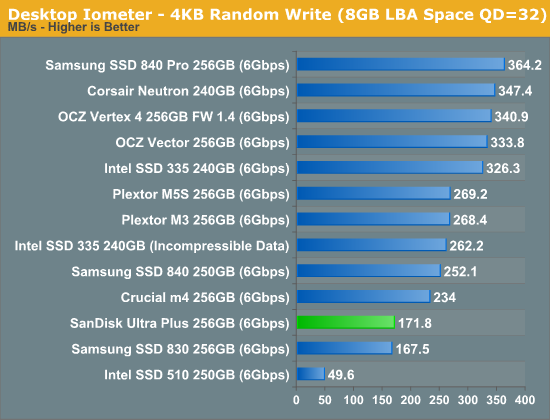
We don't see much scaling with higher queue depths, likely a limit of the Marvell SS889175's 4-channel implementation here.
Steady State 4KB Random Write Performance
SanDisk has a completely separate division that handles enterprise drives, but I was curious to see what steady state 4KB random write performance using a 100% LBA span would look like. To find out I borrowed from our Enterprise Storage tests and compared to the results from our OCZ Vector review. Note that many of these drives are enterprise focused and as a result do much better so don't get too turned off by the comparison:
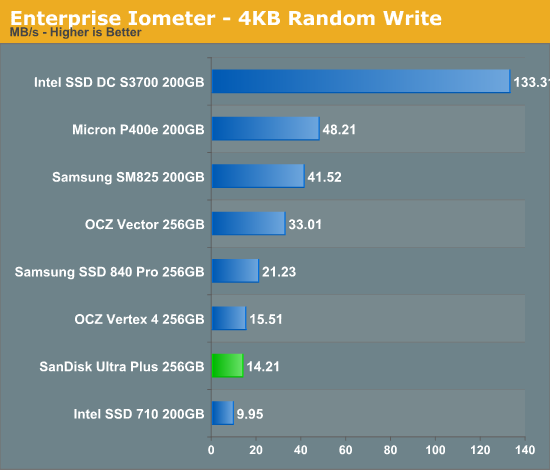
The Ultra Plus fares much better than I expected, nipping at the heels of the Vertex 4. The Vertex 4 used similar Marvell silicon so I'm not too surprised here.
Sequential Read/Write Speed
To measure sequential performance I ran a 1 minute long 128KB sequential test over the entire span of the drive at a queue depth of 1. The results reported are in average MB/s over the entire test length.
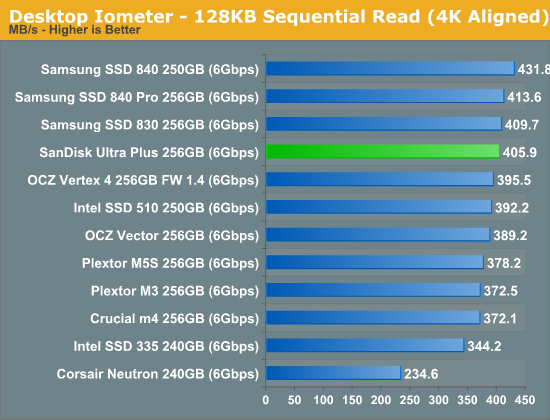
Like most drive vendors looking to address the light use client market, SanDisk's sequential read performance is actually really good.
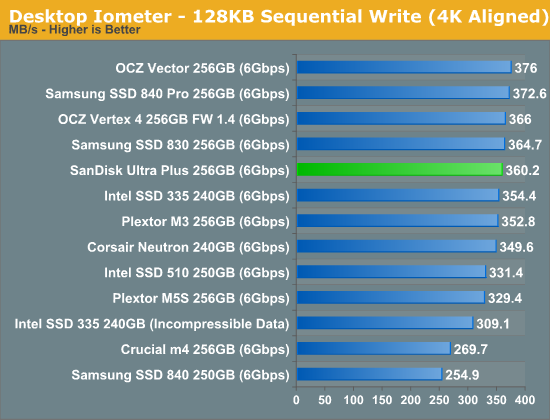
Low queue depth sequential write speed is also quite competitive, both of these will help deliver a pretty decent client experience.
AS-SSD Incompressible Sequential Performance
The AS-SSD sequential benchmark uses incompressible data for all of its transfers. The result is a pretty big reduction in sequential write speed on SandForce based controllers.
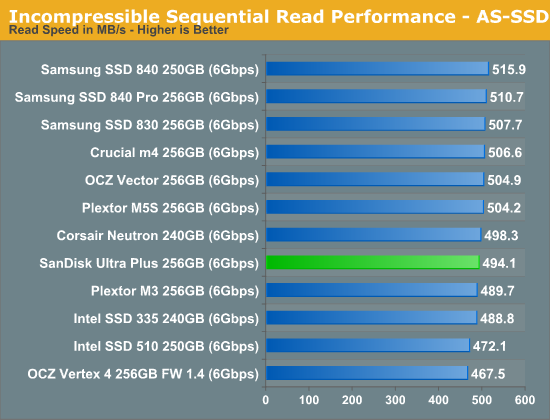
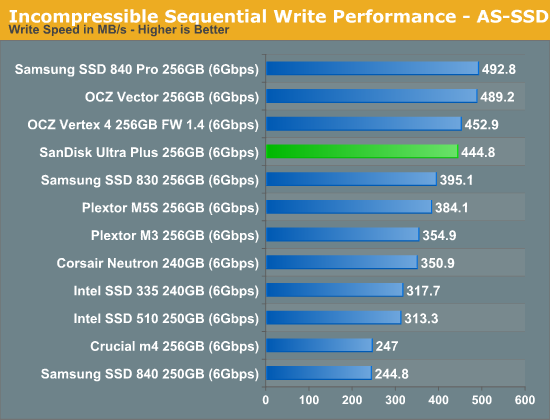
Higher queue depth sequential IO is still very good on the Ultra Plus. There's no penalty to using incompressible data as the controller does no real time data compression/de-duplication.










38 Comments
View All Comments
Flunk - Monday, January 7, 2013 - link
If you want real performance you could make a versio of this that features two of these PCBs along with a RAID chip for enhanced performance. All in a 2.5" form factor would be quite compelling.bmgoodman - Monday, January 7, 2013 - link
Sorry, but after the way SanDisk handled the TRIM issue on their SanDisk Extreme hard drives last year, I will NEVER buy from them again. I understand mistakes are made and things don't go as expected, but for the longest time they simply would not comment at all on the problem. Their response plan to bury their heads in the sand is NOT a strategy for good customer support.Quoth the raven, "nevermore!"
magnetar - Monday, January 7, 2013 - link
IMO, SanDisk handled the SandForce 5.0 firmware TRIM issue as it needed to be dealt with, carefully and professionally.The weak statement about it from a SanDIsk forum moderator that was buried in a thread started by a SanDisk customer was apparently missed by most of those concerned about this issue. That was a mistake. Responding to angry demands for a release date is not professional.
The other SSD manufactures that provided the fixed firmware very quickly were not doing their customers a favor. That indicated to me that those manufactures did very little testing and verification of the new firmware. Considering that all the SSD manufactures that used the 5.0 firmware, and SandForce itself missed finding the problem, a careful approach with the new firmware was warranted.
The firmware update SanDisk provided not only included the fixed firmware, but other fixes as well, including a fix for the incorrect temperature reading some of the Extreme SSDs had. SanDisk chose to provide one update with multiple fixes, rather than multiple firmware updates, which was the better option IMO. The more firmware updates necessary, the less professional the product is.
The R211 firmware update program SanDisk provided was the best one I've ever used. Running in Windows, it worked with the SanDisk Ex connected to the Marvell 9128 SATA chipset! Any other firmware update programs can do that? The lack of complaints about that firmware update program in the SanDisk forum also indicates how good it is.
No blemish on SanDisk IMO, actually exactly the opposite.
Kevin G - Monday, January 7, 2013 - link
Looking at the PCB for this drive makes me feel that this was a precursor to an mSATA version down the road. Hacking off the SATA and power connector for an edge connector looks like it'd be the right size. Kinda makes one wonder why they just didn't using a mSATA to SATA adapter in a 2.5" enclosure and launch both products simultaneously.Kristian Vättö - Monday, January 7, 2013 - link
SanDisk X110 was launched alongside the Ultra Plus, which is essentially an mSATA version of the Ultra Plus.perrydoell - Tuesday, January 8, 2013 - link
How about making the PCB 4x larger... 1GB SSD drive!vanwazltoff - Monday, January 7, 2013 - link
most companies purposely put out a high performing ssd and a low performing ssd, this probably their low end or more likely they are trying to shrink power consumption and size for smaller form factors such as tablets. sandisks extreme ssd went toe to toe with an 830 and proved itself a worthy component with more leveled results than an 830. i am sure they will have answer to the 840 pro soon enoughDeath666Angel - Monday, January 7, 2013 - link
The Extreme was a normal SF-2281 offering with Toggle Mode NAND. Nothing fancy about that imho.iaco - Monday, January 7, 2013 - link
64 GB packages. Verrrry nice.Tells me what we've known all along: Apple has no excuse charging obscene prices for NAND on their iPads, iPhones and Macs. 64 GB probably costs what, $50 at retail? Apple wants $200 to upgrade from 16 to 64 GB.
Maybe they'll finally get around to updating the iPod classic.
Kristian Vättö - Monday, January 7, 2013 - link
8GB 2-bit-per-cell MLC contract price is currently $4.58 ($0.57) on average according to inSpectrum. That would put the cost of 64GB MLC NAND to $36.50. Price depends on quality, though, but smartphones/tablets in general don't use the highest quality NAND (the best dies are usually preserved for SSDs, the second tier NAND is for phones/tablets).